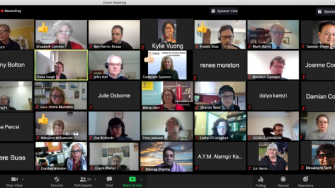
Thirty-five people attended the two-hour research priorities webinar on Wednesday 2 September 2020 organised by the Centre for Primary Health Care and Equity, UNSW in collaboration with Sydney Local Health District (SLHD), South Eastern Sydney Local Health District (SESLHD) and Central and Eastern Sydney Primary Health Network (CESPHN).
The purpose of the day was: to build on the Central and Eastern Sydney primary and community health research priorities identified at the previous workshops held in 2016, 2018 and 2019; explore ways to maximise use of the research findings from the Central and Easter Sydney Primary and Community Health Linage Resource (CES-P&CH) to improve policy and practice; and to inform a program of work using the CES-P&CH for 2020 and beyond. The workshop was chaired by Professor Mark Harris, Executive Director, CPHCE. The Webinar was divided into two sessions (1) translating what we have found into practice and (2) identification of research priorities.
As a prelude to the first session A/Prof Margo Barr, who leads the CES-P&CH team, provided information on the findings from the research to date including: (i) Impact of GP care plans on health outcomes, (ii) GP follow-up after hospitalisation on subsequent hospitalisations, (iii) impact of social isolation on health service use and health outcomes, and (iv) health service use in over 75 years.
The group discussion on translating what we have found into practice focused on GP follow-up after hospitalisation on subsequent hospitalisations. Discussion about translation into practice included: improving the quality of discharge plans, appropriateness of discharge plans instructing people to go back to ED if they have problems rather than going to see their GP, need for and ways that community health workers can be used to improve communication between hospitals and GPs, enablers for GPs to help them keep patients in the community, alternative communication channels for GPs and hospitals, impact of telehealth, and opportunities to proactively target those who are less likely to see their GP after a hospitalisation (female, less educated, working part-time or full-time, having private health insurance, drinking 1-13 alcoholic drinks a week, self-rated good health, having been hospitalised in the year prior). Ways identified by the group to maximise translation of research to practice at the meeting included: targeted discussions on findings as they arise, preparation of infographics of the findings, and policy briefs on what it means.
The second session involved breaking the group into five ‘breakout rooms’ where the participants identified their research priorities. The priorities identified included: health service use and socioeconomic status – mapping by area, How carers are used to facilitate access to care, how to build GP capacity; emergency department and hospitalisations for people less than 75 years of age, diabetes and cardiovascular disease – usage patterns and predictors of use, exploring social determinants, preventing unplanned hospitalisations, telehealth according to demographic groups, emerging populations groups including co-design, transition from hospital to community and having linkages to additional datasets, such as the non-admitted data collection, to achieve these.
These were voted on by the group and the top four were: (1) Telehealth according to demographic groups, (2) Transition from hospital to community, (3) Emerging populations groups including co-design, and (4) Preventing unplanned hospitalisations. The Chair highlighted that the Management group would develop three to four research questions for each of these priority areas—applying primary health care, feasibility and policy relevance lenses—and up to three will be selected as the CES-P&CH research projects for 2020/2021, along with the partner specific projects. He also thanked everyone for attending and hoped that we would be able to hold the next Forum face-to-face.
Please see links below for the presentation, program and summary report.
